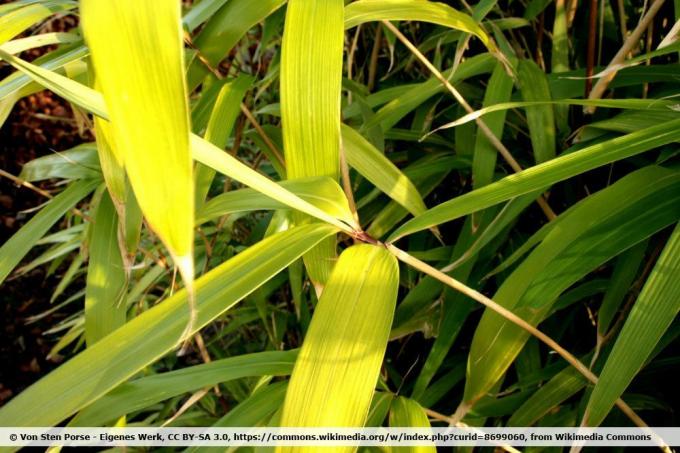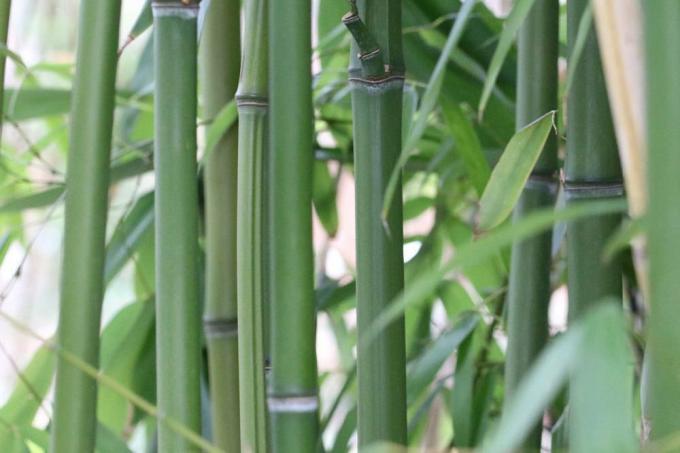
table of contents
- Bamboo species
- Bamboo species without runners
- Runners-forming bamboo species
- Bamboo that remains small
The bamboo, which comes from Asia, is not only very popular with panda bears, but also a versatile design element in the garden: So Some species can be planted wonderfully as a privacy hedge, while others even become a ground cover due to their low growth suitable. The easy-care grass can also be cultivated in the bucket, as long as there is sufficient water there. The selection of different varieties is huge, so we are introducing you to some of the most beautiful ones here.
Bamboo species
There are around 1,400 different types of bamboo worldwide, most of which - around 500 - are native to China. Another 100 species come from Japan. Although bamboo is mostly associated with an Asian flair, with a proportion of around 130 different species, a large proportion of the global bamboo occurrence comes from South America. Some varieties are also native to Africa and Australia. Of all these different species, however, only a few can be cultivated in the garden in the Central European climate. Essentially, these are the so-called umbrella bamboo (Fargesia) and the flat tube bamboo (Phyllostachys), both of which are available in a wide variety of varieties.
Note: Not everything that is called “bamboo” is actually one. The lucky bamboo, also known as "Lucky Bamboo", looks very similar to bamboo plants, but belongs to the dragon trees (Dracaena). Even the sky bamboo (Nandina domestica) is not a real bamboo species, instead it is a barberry family (Berberidacea).
Bamboo species without runners
Many people do not dare to plant or plant the giant grass in their garden. only grow it in a large tub. The reason for this is the assumption that all types of bamboo form subterranean runners that are difficult to negotiate. In fact, many bamboos reproduce very quickly in this way, which is why they should not be planted without a stable root barrier - but this does not apply to all. In particular, the Fargesia species, also known as "umbrella bamboo", only form clumps and do not spread uncontrollably through strong rhizomes. These varieties can also be cut off with a spade if necessary (e.g. if they are too big for their location), are very hardy and therefore well suited for garden design.
Fargesia murielae 'Maasai' ("columnar bamboo")
- Growth habit: columnar upright
- Height: 200 to 300 centimeters
- Runners: no
- Culms: green, blue frosted
- Leaves: whitish green
- Use: Individual and group planting, for hedges and as a privacy screen, in pots
- Location: sun to shade
- Winter hardiness: very good
Fargesia murielae 'Simba' ("Mane Bamboo")
- Growth habit: compact, overhanging
- Growth height: 150 to 250 centimeters
- Runners: no
- Stalks: green
- Leaves: pale green, narrow
- Use: for hedges, keeping pots
- Location: partial shade
- Winter hardiness: very good
Fargesia murielae 'Emerald'
- Growth habit: upright, dense, spreading
- Growth height: 150 to 250 centimeters
- Runners: no
- Culms: brownish
- Leaves: lanceolate, medium green
- Use: as a solitary, for hedges and as a privacy screen
- Location: partial shade
- Winter hardiness: very good
Fargesia murielae 'Superjumbo'
- Growth habit: bushy
- Height: 200 to 300 centimeters
- Runners: no
- Culms: dainty, greenish
- Leaves: narrow, evergreen
- Use: Solitary planting, for hedges, as a privacy screen
- Location: partial shade to shade
- Winter hardiness: well hardy
Fargesia murielae 'Winter Black'
- Growth habit: upright
- Height: 200 to 300 centimeters
- Runners: no
- Culms: black in winter
- Leaves: green, elongated
- Use: Individual and group planting, privacy protection, for Japanese gardens
- Location: sun to shade
- Winter hardiness: very good
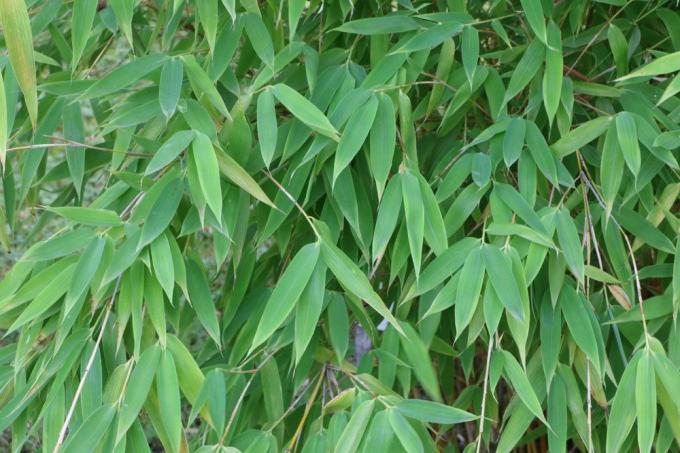
Fargesia nitida ("Red or fountain umbrella bamboo")
- Growth habit: dense, well branched, overhanging like an umbrella
- Growth height: 250 to 400 centimeters
- Runners: no
- Culms: narrow, reddish (the sunnier the location, the more intense the color)
- Leaves: narrow, delicate, deep green
- Use: as a solitary and group plant, for hedges, as pond bank planting, for tubs
- Location: sun to partial shade
- Winter hardiness: well hardy
Fargesia nitida 'Jiuzhaigou 1'
- Growth habit: upright
- Height: 200 to 400 centimeters
- Runners: no
- Culms: bright red
- Leaves: elongated, dark green
- Use: as bank planting, privacy screen or hedge, for planting in pots
- Location: sun to partial shade
- Winter hardiness: very good

Fargesia robusta 'Campbell'
- Growth form: upright, later overhanging
- Height: 350 to 500 centimeters
- Runners: no
- Culms: narrow, greenish-brown
- Leaves: elongated, delicate, dark green with a bluish underside
- Use: Individual and group planting, for hedges and as a privacy screen, for planting in pots
- Location: partial shade
- Winter hardiness: conditionally hardy, winter protection makes sense
Fargesia rufa
- Growth habit: very dense, broad, compact and overhanging
- Growth height: 150 to 250 centimeters
- Runners: no
- Culms: narrow, brownish-green
- Leaves: deep green, delicate
- Use: for group and solitary plantings, in borders (e.g. B. with perennials), as
- Privacy protection, in buckets
- Location: Sun to partial shade, very sun-tolerant
- Winter hardiness: winter protection makes sense
Fargesia scabrida 'Asian Wonder'
- Growth habit: well branched, upright
- Height: 300 to 400 centimeters
- Runners: no
- Culms: bluish
- Leaves: elongated, shiny, dark green to reddish
- Use: for individual and group planting
- Location: sun to partial shade
- Winter hardiness: good
Runners-forming bamboo species
The species and varieties presented in this section are all characterized by strong runners. Therefore, never plant these varieties without at least 70 centimeters deep Root barriers in the garden or It is best to cultivate them in a sufficiently large planter (e. B. a mason's bucket).
Phyllostachys aurea ("golden cane bamboo")
- Growth habit: bushy, dense, upright
- Height: 300 to 500 centimeters
- Runners: yes
- Culms: golden yellow to green, up to 2.5 centimeters in diameter
- Leaves: strong green
- Use: single and hedge planting, as a privacy screen
- Location: sun to partial shade
- Winter hardiness: good
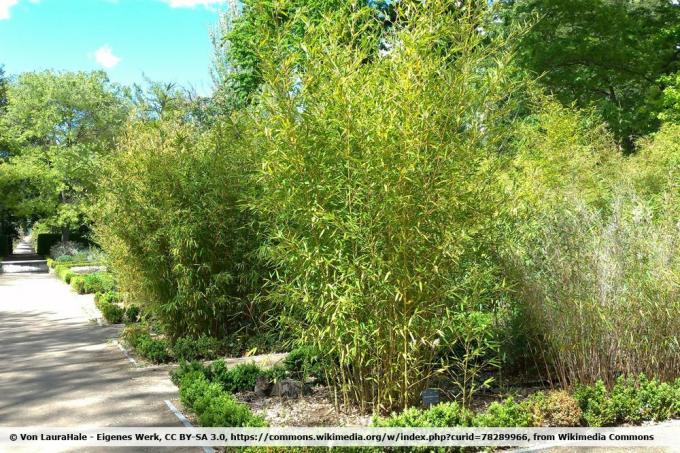
Phyllostachys aureosulcata 'Spectabilis'
- Growth form: upright, overhanging
- Height: 300 to 500 centimeters
- Runners: yes
- Culms: green-yellow striped, up to four centimeters in diameter
- Leaves: delicate, green with isolated white stripes
- Use: single and hedge planting, as a privacy screen, in pots
- Location: sun to partial shade
- Winter hardiness: very good
Phyllostachys bissetii ("green bamboo")
- Growth habit: very dense, bushy, overhanging
- Height: 600 to 800 centimeters
- Runners: yes
- Culms: glossy dark green
- Leaves: glossy dark green
- Use: Individual and group planting, as a privacy screen
- Location: sun to partial shade
- Winter hardiness: very good
Phyllostachys glauca
- Growth habit: upright
- Growth height: 400 to 800 centimeters
- Runners: yes
- Culms: blue to turquoise when young, later green
- Leaves: dark green
- Use: solitary planting, bamboo grove, as privacy screen
- Location: sun to partial shade
- Winter hardiness: very good
Phyllostachys humilis ("bronze bamboo")
- Growth habit: upright, overhanging
- Height: 300 to 500 centimeters
- Runners: yes
- Culms: bronze to dark green
- Leaves: narrow, small
- Use: single and hedge planting, as a privacy screen
- Location: sun to partial shade
- Winter hardiness: very good
Phyllostachys flexuosa ("lovely bamboo")
- Growth habit: dense, bushy
- Height: 300 to 400 centimeters
- Runners: yes
- Stalks: green
- Leaves: delicate, light green to yellowish
- Use: single and hedge planting, as a privacy screen
- Location: sun to partial shade
- Winter hardiness: very good
Phyllostachys nigra ("black tube bamboo")
- Growth form: upright, overhanging
- Height: 400 to 600 centimeters
- Runners: yes
- Culms: green when young, later dark to black
- Leaves: small, dense, dark green
- Use: single and hedge planting, as a privacy screen
- Location: sun to partial shade
- Winter hardiness: very good
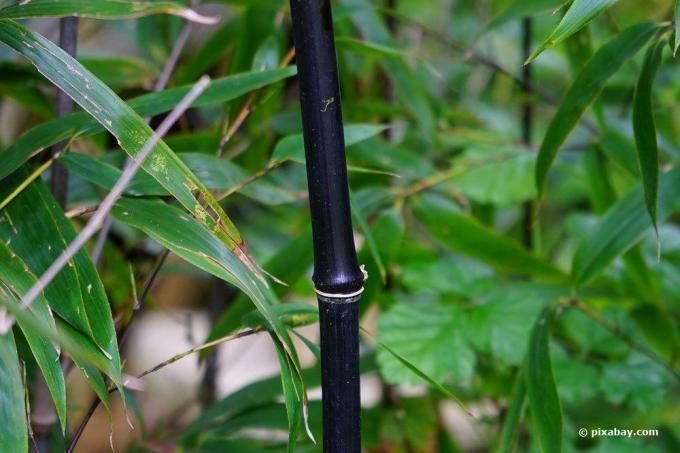
Phyllostachys nigra 'Boryana' ("Tiger Bamboo")
- Growth form: upright, overhanging
- Growth height: 400 to 800 centimeters
- Runners: yes
- Culms: up to six centimeters in diameter, dark green to bluish with brown spots
- Leaves: dark green, dense
- Use: Solitary and grove planting, as a privacy screen
- Location: Sun to partial shade, protected
- Winter hardiness: sensitive, for mild regions
Phyllostachys nigra `Henonis` (" golden hair bamboo ")
- Growth form: upright, dense, overhanging
- Height: 400 to 700 centimeters
- Runners: strong runners
- Culms: up to five centimeters in diameter, green to olive-colored
- Leaves: glossy green
- Use: Solitary and hedge planting, as a bamboo grove
- Location: sun, protected
- Winter hardiness: good
Phyllostachys nigra 'Punctata'
- Growth form: upright, overhanging
- Height: 300 to 600 centimeters
- Runners: yes
- Culms: green when young, later with brown spots and turning black
- Leaves: glossy dark green, small
- Use: single and hedge planting, as privacy screen, for bamboo groves
- Location: sun, protected
- Winter hardiness: good
Phyllostachys parvifolia ("gold bamboo")
- Growth habit: upright
- Growth height: 400 to 800 centimeters
- Runners: strong runners
- Culms: green, later shimmering gold
- Leaves: small, pale green
- Use:
- Location: Solitary planting, for bamboo grove, as privacy screen
- Winter hardiness: good
Phyllostachys vivax 'Huangwenzhu'
- Growth form: upright, overhanging
- Height: 600 to 1200 centimeters
- Runners: strong runners
- Culms: shiny green with yellow stripes
- Leaves: oblong, green
- Use: Solitary planting, for bamboo groves, as privacy protection
- Location: sun, protected
- Winter hardiness: sensitive, for mild regions
Pseudosasa japonica ("Japanese arrow bamboo")
- Growth form: upright, overhanging
- Height: 300 to 500 centimeters
- Runners: only strongly runners-forming in old age
- Culms: thin, green
- Leaves: green
- Use: solitary or hedge planting
- Location: Sun to partial shade, likes warmth
- Winter hardiness: good
Bamboo that remains small
Although bamboo is a grass, many of these species reach heights of growth similar to trees. Some varieties, such as the giant bamboo, can grow up to 40 meters high in their natural habitats. However, this does not apply to all types of bamboo, some remain very low and are therefore also suitable as ground cover, for small gardens or for keeping in a bucket.
Fargesia murielae 'Bimbo'
- Growth habit: compact and dense
- Height: 100 to 200 centimeters, slowly growing (20 to 30 centimeters per year)
- Runners: no
- Stalks: delicate, brownish
- Leaves: strong light green
- Use: Solitary planting, for hedges, on pond edges, in pots
- Location: partial shade to shade
- Winter hardiness: well hardy
Pleioblastus fortunei 'Variegata'
- Growth habit: bushy, dense
- Height: 50 to 100 centimeters
- Stalks: dainty, green
- Leaves: green-white striped, elongated
- Use: as a ground cover, as a companion plant for perennials, as underplanting of woody plants
- Location: partial shade to shade
- Winter hardiness: good
Pleioblastus pygmaeus
- Growth form: upright, bushy, dense
- Height: 40 to 100 centimeters
- Runners: yes
- Culms: thin
- Leaves: small, up to five centimeters long, green
- Use: low hedge, underplanting of trees and shrubs, as
- Accompanying planting, as a lawn substitute
- Location: sun to partial shade
- Winter hardiness: good
Pleioblastus shibuyanus 'Tsuboi'
- Growth habit: upright, bushy, overhanging
- Height: 50 to 150 centimeters
- Runners: yes
- Culms: thin
- Leaves: green with white or yellow stripes
- Use: low hedge, underplanting of trees and shrubs, as
- Accompanying planting, as a bonsai
- Location: sun to partial shade
- Winter hardiness: good
Sasa palmata 'Nebulosa'
- Growth habit: flat, strong
- Growth height: 150 to 250 centimeters
- Runners: strong runners
- Culms: green when young, later yellowish with brown spots
- Leaves: arranged like a palm, up to 30 centimeters long, green
- Use: extensive planting, for long and wide hedges, as underplanting
- Location: sun to partial shade
- Winter hardiness: good
Sasa tesselata ("large leaf bamboo")
- Growth habit: broad, upright
- Height: 100 to 200 centimeters
- Runners: strong runners
- Culms: thin, green
- Leaves: very large, firm and deep green leaves, up to 40 centimeters long
- Use: area planting, underplanting, for tubs (overwinter frost-free!)
- Location: partial shade to shade, protected
- Winter hardiness: sensitive, for mild and protected locations
Shibataea kumasaca ("butcher's broom bamboo")
- Growth habit: bushy, dense
- Height: 60 to 120 centimeters
- Runners: short runners
- Culms: green with short branches
- Leaves: small, wide, green
- Use: Solitary and accompanying planting, as underplanting or small hedge, for
- Bucket and as a bonsai
- Location: Sun to partial shade, protected
- Winter hardiness: very good

tip: Many varieties of the tropical and subtropical bamboo species are also very suitable as indoor plants. These include the Bambusa species (e. B. Bambusa ventricosa or Bambusa vulgaris, here in particular the 'Wamin' variety) or the very pretty ones Chimonobambusa varieties (e.g. Chimonobambusa marmorea 'Variegata' Chimonobambusa quadrangularis 'Tatejima'). On the other hand, the species and varieties from the temperate climatic zones are not suitable as indoor plants, as these require a cool wintering and are not allowed to stand in the warm all year round.

